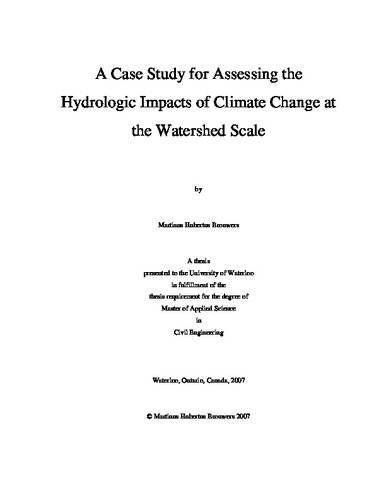| dc.contributor.author | Brouwers, Martinus Hubertus | |
| dc.date.accessioned | 2008-01-23 18:29:56 (GMT) | |
| dc.date.available | 2008-01-23 18:29:56 (GMT) | |
| dc.date.issued | 2008-01-23T18:29:56Z | |
| dc.date.submitted | 2007 | |
| dc.identifier.uri | http://hdl.handle.net/10012/3514 | |
| dc.description.abstract | Since the advent of the industrial era atmospheric concentrations of greenhouse gases have been on the rise leading to increasing global mean temperatures. Through increasing temperatures and changes to distributions of precipitation, climate change will intensify the hydrologic cycle which will directly impact surface water sources while the impacts to groundwater are reflected through changes in recharge to the water table. The IPCC (2001) reports that limited investigations have been conducted regarding the impacts of climate change to groundwater resources.
The complexity of evaluating the hydrologic impacts of climate change requires the use of a numerical model. This thesis investigates the state of the science of conjunctive surface-subsurface water modeling with the aim of determining a suitable approach for conducting long-term transient simulations at the watershed scale. As a result of this investigation, a coupled modeling approach is adopted using HELP3 to simulate surface and vadose zone processes and HydroSphere to simulate saturated flow of groundwater. This approach is applied to the Alder Creek Watershed, which is a subwatershed of the Grand River Watershed and located near Kitchener-Waterloo, Ontario. The Alder Creek Watershed is a suitable case study for the evaluation of climate change scenarios as it has been well characterized from previous studies and it is relatively small in size.
Two contrasting scenarios of climate change (i.e., drier and wetter futures) are evaluated relative to a reference scenario that is based on the historical climatic record of the region. The simulation results show a strong impact upon the timing of hydrologic processes, shifting the spring snow melt to earlier in the year leading to an overall decrease in runoff and increase in infiltration for both drier and wetter future climate scenarios. Both climate change scenarios showed a marked increase to overall evapotranspiration which is most pronounced in the summer months. The impacts to groundwater are more subdued relative to surface water. This is attributed to the climate forcing perturbations being attenuated by the shift of the spring snow melt and the transient storage effects of the vadose zone, which can be significant given the hummocky terrain of the region. The simulation results show a small overall rise of groundwater elevations resulting from the simulated increase in infiltration for both climate change scenarios. | en |
| dc.language.iso | en | en |
| dc.publisher | University of Waterloo | en |
| dc.subject | climate change | en |
| dc.subject | groundwater | en |
| dc.subject | surface water | en |
| dc.title | A Case Study for Assessing the Hydrologic Impacts of Climate Change at the Watershed Scale | en |
| dc.type | Master Thesis | en |
| dc.pending | false | en |
| dc.subject.program | Civil Engineering | en |
| uws-etd.degree.department | Civil and Environmental Engineering | en |
| uws-etd.degree | Master of Applied Science | en |
| uws.typeOfResource | Text | en |
| uws.peerReviewStatus | Unreviewed | en |
| uws.scholarLevel | Graduate | en |

